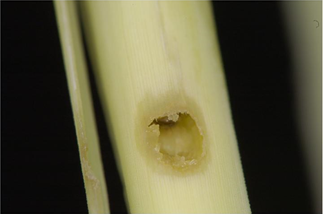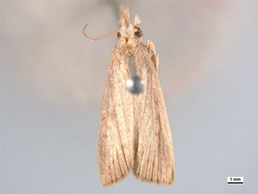PLANT PEST

Chilo terrenellus. N. Sallam, BSES, PaDIL
Stem borers of sugarcane (Chilo spp.) (exotic species)
Exotic to Australia
Features: Medium to large moths that eat through sugarcane plantations as caterpillars
Where they’re from: Indonesia, New Guinea and sometimes on nearby islands including in Torres Strait
How they spread: Importation of caterpillars or eggs on infested sugarcane; local spread by flying moths
At risk: Sugarcane, rice, sorghum and corn
Keep it out
Keep it out/stop the spread
Stem borers of sugarcane are a group of related insects that feed inside canes causing extensive damage. The borers are big eaters, sometimes ruining 70–80 per cent of the crop.
Many of this group of borers, as well as their preferred host—sugarcane—are native to New Guinea. Some have been known to make it across to islands in the Torres Strait, so biosecurity efforts are focussed on preventing the spread across to the Australian mainland.
The amount of damage these borers cause in crops varies with the particular species. The most severe losses occur with:
- top borer (Scirpophaga excerptalis)
- ramu shoot borer (Sesamia grisescens)
- stalk borer (Chilo sacchariphagus)
- stalk borer (Chilo terrenellus).
Adults are medium sized grey or white moths that lay eggs in sugarcane. Larvae hatch out and feed, creating tunnels in the stem that kill the plant.
Stem borers threaten Australia’s valuable sugarcane industry and the communities that rely on it.
Importing goods
To keep sugarcane stem borers out of Australia, never ignore Australia’s strict biosecurity rules.
Import shipments may need to be treated and certified, so before you import, check our Biosecurity Import Conditions system (BICON).
Growers
Be aware that Queensland has Sugar Cane Biosecurity Zones to stop the spread of unwanted pests and diseases. Always comply with these biosecurity restrictions to prevent the spread of pests and weeds. A map of these areas is available from the Queensland Department of Agriculture and Fisheries website (PDF).
What to look for
- Adults are medium sized grey or white moths.
- Grubs are 3-5 cm long and create tunnels in stems.
- Small holes may be visible on infested stalks.
- Upper leaves turn brown.
- Eggs on the underside of leaves.
- Frass (faecal pellets) caught in the lower leaves.


Where to look
Importers
Importation of infested cane poses the greatest threat of stem borers of sugarcane making it to Australia. The importation of sugarcane into Australia is prohibited, except for setts specifically imported for propagation at approved post-entry facilities.
Growers
- Abide by restrictions that apply in sugarcane biosecurity zones.
- Use good plantation biosecurity including:
- always purchasing cane that has been inspected by a Sugarcane Productivity Service provider
- monitoring your crops frequently
- practicing good farm hygiene.
Everything you need to know is available from Farm Biosecurity.
What to do
If you think you’ve found sugarcane infested with stem borer:
- take a photo
- do not disturb infected plants (this may be as simple as closing the doors on a shipping container or covering infested canes with paper bags or fertiliser bags tied tightly around the stems.)
